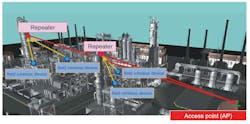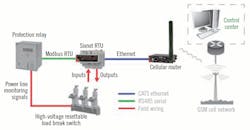Figure 1: Pump jacks at Chevron's San Joaquin Valley business unit in California's Central Valley use radios to transmit data from automated testing of groups of wells and managed steam flooding needed by heavy-oil applications, but they're supported by 25-gallon chemical tanks with smart lids that are transitioning to less costly LoRaWAN and LTE cellular to report levels and other data. Source: Chevron
It's well known that reach often exceeds grasp, but wireless lets process applications and users grasp as far as they want. Plus, updated wireless standards and devices are letting them do it more easily and at less cost than ever.
"Oil and gas wells have been in California's Central Valley for 100 years, and wireless was used in the form of radios for 40 years in multiple locations. This is because we have to cover thousands of pump jacks over 100 square miles, and wireless is the only way. The radios were point-to-multi-point, and now we have wireless Ethernet and licensed, point-to-point, private microwave communications," says Jonathan Polly, solutions operations architect at Chevron's San Joaquin Valley business unit (SJVBU), which operates six oil and gas fields in the valley. "The pump jacks are instrumented with wireless to transmit data from automated testing of groups of wells and managed steam flooding needed by the heavy oil applications." (Figure 1)
However, even though SJVBU used radios for decades, these older wireless methods were more costly and less flexible, making it impractical to get all the data they need. Besides learning about and adopting new wireless technologies, SJVBU also retained radio frequency (RF) procedures and skills that were still useful even as they sought to modernize.
LoRaWAN in the valley
"We have 18,000 wells and devices in the field to operate and maintain, and many data points were still manually collected. However, even though there was a lot of ‘windshield time’ spent driving around collecting data, it would have been prohibitively expensive to add traditional radios to all of them," explains Polly. "We also used our RF infrastructure for management of thousands of 250-gallon tanks that support well health, corrosion prevention, and adding treatments to the wells and flowlines to optimize production. These tanks used to be checked with dipsticks, but we recently added 'smart lids,' similar to what you might find at Disney World or in smart cities to monitor trash. Our smart lids take level readings, and transmit data over a Long Range Wide Area Network (LoRaWAN) using nodes with 10-year batteries that can transmit over 10 miles in ideal conditions, which is more cost-effective than cellular alone. In the future, we're going to see if we can use these nodes and LoRaWAN to monitor temperature, pressure, vibration and soil samples."
One reason LoRaWAN is inexpensive is because as many as 2,000 nodes can transmit to a centralized gateway, which enables SJVBU to cover its six fields and hundreds of square miles with just a couple of dozen gateways. Polly reports this transition from legacy radios to LoRaWAN was enabled by an interdisciplinary team that broke down former technical and organizational silos by combining legacy RF know-how with newer application and code development capabilities.
"We needed everyone's perspective to succeed," says Polly. "In the end, the economics of these wireless, low-power, WAN opportunities were a no-brainer, so we just did it. We achieved a significant return on investment (ROI) and reduced drive time, while optimizing the supply chain and using easily deployable technology. In general, LoRaWAN is an order of magnitude less costly than traditional radios and wireless, so we're looking at other use cases for it, such as routine operating duties."
Fewer levels, lower costs
From short- to long-range, there are many wireless technologies, protocols and standards. The most well-known and widely deployed include:
- IEEE 802.15.1 (Bluetooth)
- IEEE 802.11a-n (WiFi) and IEEE 802.11ac (faster WiFi)
- ANSI/ISA 100.11a and IEC 62734, "Wireless communication network and communication profiles" (ISA 100)
- IEEE 802.15.4 and IEC 62591, "Industrial Networks—wireless communication network and communication profiles" (WirelessHART)
- LoRa and LoRaWAN (long-range, wide-area network)
- 6LoWPAN (IPv6 over low-power, wireless personal area network)
- NB-IoT (narrow-band Internet of Things for slower, 250-kbps peak, lower-power applications)
- Category M (low-power, low-bandwidth, 1Mbps peak LTE for couple hundred kbps applications)
- 900 MHz, 2.4 and 5.6 GHz (radio)
- 3G, 4G and soon 5G LTE (broadband cellular)
- IESS (Intelsat Earth Station Standards for satellite-based communications)
Robert Ward, business development director at MultiTech, reports that SJVBU's wells and equipment are using its MultiConnect wireless nodes, Conduit programmable LoRaWAN and LTE cellular gateways, and LoRa Enterprise Network Server (LENS). Though it started in telecommunications, building automation, healthcare, irrigation and life sciences, MultiTech has been getting into oil and gas applications in recent years because LoRaWAN and cellular connections are generally less costly than other wireless links and provide point access to disparate assets that are miles apart.
"We used to focus on embedded components, such as multipurpose fax modems and LTE cell modems in critical devices like defibrillators," says Ward. "We're now providing solutions encompassing LTE field connectivity from our LoRa gateways, as well as cloud components for device management and data connectivity to common clouds like Microsoft Azure and Amazon Web Services (AWS)."
Unlike the seven-layer Purdue Open System Interconnect (OSI) model for system and control hierarchies, which requires communications to go though multiple firewalls between field devices, operations, enterprise and public networks, Ward adds that LENS is more secure and efficient because it simplifies these levels and reduces how many firewalls are needed by essentially plugging into this new process data. This is typically done by connecting a process application and its network at OSI Level 3.5 via a cloud service through potentially one firewall.
"Users like SJVBU are mainly using wireless like LoRaWAN to communicate non-critical information," adds Ward. "However, even though this is low- or non-consequence data, a lot of good value and better decisions can be gained from it."
Acceptance, invisibility, IIoT
It's ironic that as soon as innovative technologies like wireless succeed and become accepted, they also starts to become transparent—and wireless is no exception, even though it's largely invisible to begin with. This is a problem because gaining critical mass and going mainstream also means being taken for granted, which can stifle future inquiry and innovation in that area, just as calculators supposedly blunt mathematical thinking skills. This evolution happened to fieldbuses and Ethernet, and now this fade-out is happening to wireless.
This is doubly unfortunate because thoroughly understanding and applying wireless is one of the best ways to multiply the reach and effectiveness of other industrial networks. However, it's never too late to look under the table, and see—or be reminded—how underpinnings like wireless can improve performance. It always bears repeating that wireless doesn't just save cable and materials, but it allow signals and data to be gathered that were previously too remote, costly or hard to reach. Of course, this makes wireless a perfect enabler for the Industrial Internet of Things (IIoT) and other digitalization projects that are getting more attention lately.
"Wireless in industrial applications has, for the most part, become well-accepted and even commonplace, which can make it a bit invisible. We typically don't have to convince users to try it because they already know its benefits. All we have to do is match each wireless technology to its appropriate application," says Garrett Schmidt, senior product manager for communication interfaces at Phoenix Contact. "This means understanding each application's individual needs; checking on the approved frequency band for that country; and determining the range that needs to be covered by the wireless network, how many nodes are needed in the network, and what kind of data it's communicating, such as I/O signals, Ethernet or a fieldbus?
"For example if a client needs level data from a tank that's two miles away, then they might not be able to use WirelessHART technology. It’s not meant to cover long distances, but is meant to build a mesh network inside of a plant or within a few hundred square meters. In this case, we can create a simple, point-to-point wireless connection with our Trusted Wireless 900 MHz radios. Increasingly, thought must be put into wireless network designs. Users in operations technology (OT) may want wireless, but they have to make sure it won't stomp on the corporate network. Since these are usually 2.4 GHz and owned by information technology (IT), so OT may need to find wireless products that run at a different frequency like 900 MHz."
Site surveys, assessments still essential
Despite all the advances wireless has made in recent years, it's universally agreed that each potential wireless application and location must have a site survey and assessment to identify any unique issues or problems, and determine the most appropriate solution that will best meet its individual needs.
Schmidt adds that wireless is accepted because everyone has WiFi routers at home, but even though users are comfy with it, that's not enough for it to run reliably in industrial environments. "There are always obstructions and interference that wasn't expected, whether it's from steel structures, unrelated microwave signals, vehicles or whatever. This is why it's still important to do site studies," says Schmidt. "When we consult with clients, we bring on nodes and gateways, set them up, run them, see how they work, and solve any issues we may find in that particular application. Data types include serial, analog and digital I/O, Modbus, Profibus, Ethernet and others, and they all have different behaviors and requirements. For instance, all Ethernet protocols aren't created equal; Profinet may have some quality of service (QoS) requirements; while some EtherNet/IP may broadcast a lot of traffic that can clog up a wireless network. Many users want to use IP-based security cameras, and send video over wireless, which can really hog data and bandwidth. This is where expert support can help test devices and integrate them properly."
Figure 2: To design stable wireless networks, Yokogawa uses its Sky Mesh installation design method, which uses repeaters to secure robust communication paths. These repeaters communicate with field devices installed among the pipelines typically found in process plants. Source: Yokogawa
"In a site survey, communication tests with actual equipment are carried out at proposed installation points to check the reliability of wireless communication paths," says Masahito Endo, transmitter division manager, Operational Technology Center, Yokogawa Electric Corp. "Yokogawa uses an installation design method called Sky Mesh, in which robust communication paths are secured by using a group of repeaters that communicate with field wireless devices installed in the pipe jungles typically found in process plants (Figure 2). Yokogawa has been successfully applying this method to many plants to create stable wireless networks. When applying Sky Mesh, it's crucial that communication paths through the repeaters can be fixed. Yokogawa's field wireless system supports automatic mesh networks and fixed path networks, allowing Sky Mesh to be applied effectively."
WirelessHART or ISA100?
Just as they must conduct site surveys and tailor wireless to meet their needs, potential users must also decide which of the two most prevalent wireless protocols will serve their application best.
"A process plant or facility considering a wireless network to connect field devices, such as instruments and actuators for monitoring and control, has two main wireless protocol choices: ANSI/ISA 100.11a or WirelessHART," says Endo. "Both were adopted by the International Electrotechnical Commission International Electrotechnical Commission as global standards. ISA100 is IEC 62734, and WirelessHART is IEC 62591, and they've been in use for about a decade.
"These two approaches have many similarities. For example, they use the same low-power IEEE 802.15.4 radio. WirelessHART’s mesh is self-healing and self-organized. ISA100.11a is also self-healing, and each node can have redundant paths, with users specifying paths to organize the network. However, the ways in which the networks are organized differ significantly. Much hinges on the way the networks form communication paths and use meshing technology, which governs how individual field devices communicate bi-directionally with each other. Another recent development is the introduction of ISA100 and WirelessHART products with explosion-proof certifications, making it easier to implement wireless in the hazardous areas often found in process plants."
Immediate data, smooth operations
Along with bringing in signals from remote and formerly inaccessible locations, wireless typically delivers data much faster, too, which enables quicker decisions and other operational efficiencies. In the wake of damage from hurricane Irene in 2011 and super-storm Sandy in 2012, engineers in Wallkill, N.Y., knew their water treatment needed an upgrade. With three pumping stations spread over a 20-mile radius, and one of the most complex water supply systems in Orange County, monitoring its water levels was a manual, time-consuming process, while the more recent extreme weather added to existing problems.
While the to-do list for any sizeable project is never complete for finished, there are still many common tasks required to design and implement wireless in process applications, multi-plant complexes and widely scattered facilities. Here are most of the high points:
- Recruit in-house, cross-functional advocates, and outside advice and expert assistance;
- Gain enterprise-level, administrative IT and plant-floor buy-in;
- Locate, list and profile all of a site's existing production equipment and processes;
- Continue site study to identify environmental and artificial impediments to wireless signals;
- Account for each kind of information produced, how it's delivered, and what new pathways are needed;
- Allow data requirements, equipment and application locations to help dictate the most suitable wireless solution;
- Examine non-wireless networking methods and devices on-site, and learn if they require any connections, interface or adjustments to cooperate with wireless devices being added;
- Once appropriate wireless solutions are selected, research applicable node, gateway, antenna, power delivery, and other equipment and software options;
- Calculate costs and return-on-investment of wireless solutions;
- Perform site tests of planned wireless components and network design to make sure they'll fulfill application requirements;
- Deploy wireless devices, monitor performance, and adjust and update as operations needs change, and as better technologies become available.
"We used to rely on landline telephones, and we had frequent breakdowns and lost communications," says Tim Grogan, water and sewer administrator, Town of Wallkill. "Basically, we had to go to each location to find out what was going on. There were discrepancies between different locations. And when we got an alarm, we'd have to go to a certain location, assess the problem there and relay information back to whoever needed to fix it."
Consequently, Wallkill's engineers worked with Phoenix Contact and Kapsch to design a synchronized, wireless network that could deliver more timely data to the utility's SCADA system, and give its technicians immediate access to water levels and other information. Their solution included Phoenix Contact's TWE with I/O functions, which can typically transmit data several miles; its FL mGuard routers to serve as firewalls and provide Layer 3 routing for the new system's cellular modems; and Kapsch's Dynac traffic and incident reporting software. Together, these devices and software give Wallkill's staff a monitoring and control platform with historical and event recording, trending and reporting to better oversee their water-supply infrastructure.
"Since we began using Phoenix Contact's wireless components, we haven't had the breakdowns, lost communications or discrepancies that we had before," adds Grogan. "Now, we receive information instantaneously that's displayed on a centralized SCADA system that we can view on our smart phones, laptops or on a monitor in the office, so we know what's going on everywhere, all the time.
"We've also become much more efficient because now we know instantaneously what problems we have and where we have them. All the information is right at our fingertips, and literally within seconds we know what's happening, why it's happening and we have a team on the way to repair it."
To make it easier for engineering teams to implement wireless solutions for water/wastewater applications once a site survey indicates what they need, Schmidt reports that Phoenix Contact has developed prepackaged kits with standardized wireless components, "We still do many one-off projects, but these kits have tried to think through what many of them will require," he adds. "For example, our EAGLEi system for water/wastewater includes cellular modem, I/O modules, controller and cloud connectivity."
Breath of life for brownfields
Beyond streamlining existing operations, wireless can also revive legacy equipment and applications, and give many a new lease on life—or at least extend their relevance—by delivering data that used to be stranded.
For instance, Empresas Publicas de Medellin, a leading multi-utility company focused on power generation, transmission and distribution, natural gas distribution, wastewater treatment, aqueducts and telecommunications, recently sought a flexible way to monitor and interact with legacy equipment across its distributed network infrastructure. EPM worked with Red Lion and electrical contractor Facelco and Red Lion to enable remote connectivity for power distribution to its reclosers, and they implemented remote connectivity by combining Facelco's network analyzer with Red Lion’s Sixnet series industrial RTUs and IndustrialPro cellular routers that deliver wireless DNP-3 connectivity to RTUs that act as a controller.
This upgrade let EPM remotely and seamlessly connect, communicate, monitor and control its existing recloser and power distribution networks, and reduce total cost of ownership (TCO) by extending the life of its infrastructure and preserving capital expenditures for other projects. In addition, Facelco's network analyzers provide real-time diagnostics that allow EPM to proactively respond to conditions to ensure system integrity and network uptime (Figure 3).
Figure 3: To monitor and interact with legacy equipment across its distributed network infrastructure, multi-utility provider Empresas Publicas de Medellin enables remote connectivity for power distribution to its reclosers by combining electrical contractor Facelco's network analyzer with Red Lion's Sixnet series industrial RTUs and IndustrialPro cellular routers that deliver wireless DNP-3 connectivity to RTUs that act as a controller.
"The primary benefit for EPM was implementing a solution that would extend the life of its existing recloser network," says Alejandro Arango, engineering director at Facelco. "This remote connectivity solution allows them to extend the life of existing legacy equipment, which can last 15-20 years, as well as increase control of the network. By working with Red Lion and Facelco, EPM was able to cost-effectively improve network control, maximize availability and protect its network investment.”
Mike Fahrion, CTO for IIoT solutions at Advantech, adds that upgrading brownfield applications and plants is the biggest opportunity for IIoT technologies, and wireless is the most effective way to deploy them because hardwiring is often too costly and disruptive.
"Everyone's familiar with Wi-Fi because they use its infrastructure, but it and a lot of IT-based devices aren't as robust for industry because there can be more RF reflections on plant floors. Plus, while sensors or instruments may be well-placed, they'll still have problems if they have a weak 2.4-GHz Wi-Fi chip and a single antenna, which is why many applications are using dual-band, 2.4- and 5-GHz devices," explains Fahrion. "For industrial applications, we prefer wireless mesh technologies, where we typically integrate sensors or I/O with wireless mesh interfaces usually in the 2.4 GHz ISM band. They're self-forming and self-healing networks, which makes them more robust and better able to deal with multi-path reflections and interference. They also have agile frequencies, and can switch channels, as well as synchronize to sleep, wake at the same time, and do housekeeping. Finally, they also bake in preconfigured algorithms that let them check and test for alternative network routes and frequencies.
"In short, users want to implement IIoT, so they can gain visibility into their business assets and solve problems, and because wireless is a fraction of the installed cost of other solutions, it allows them to afford IIoT and use it to limit disruptions in their operations. IIoT also opens the door to more wireless because there's so much focus on monitoring existing assets."









